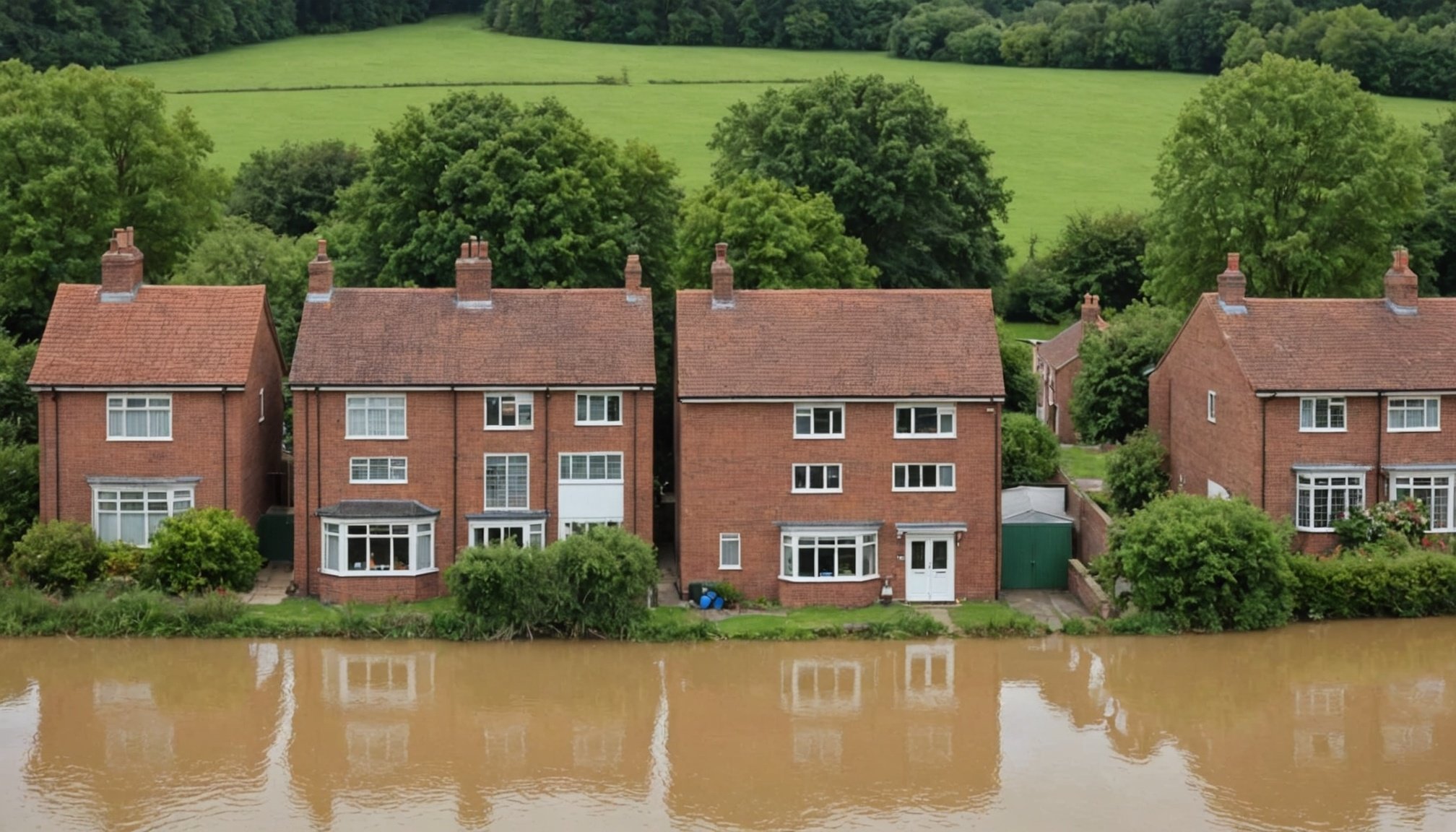Understanding Flood Zones in the UK
When considering a property purchase in the UK, understanding flood zones is crucial for assessing the potential risk to your investment. Flood zones are geographical areas that demonstrate levels of flood risk, as classified by the Environment Agency, based on extensive flood mapping.
Flood zones in the UK are divided into three main categories:
Also to discover : Find your ideal property in la tania's real estate market
- Flood Zone 1: Areas with a low probability of flooding. Having less than a 0.1% chance of being flooded each year, these zones are the least risky.
- Flood Zone 2: These areas have a medium probability of flooding, indicating an annual risk of up to 1%.
- Flood Zone 3: Properties here face the highest risk, with over 1% chance of flooding annually. This zone is further divided into Zone 3a (high probability) and Zone 3b (the functional floodplain).
Understanding these classifications is essential prior to purchasing property, as it affects insurance costs, mortgage approval, and future property value. Consulting flood maps offers a visual representation of the flood risk associated with various properties. Awareness of UK flood risk enables informed decision-making, safeguarding properties against unforeseen natural events.
Legal Obligations for Buyers
When purchasing property in flood-prone areas, understanding legal requirements is crucial. Buyers have specific responsibilities, and navigating these can be daunting yet necessary. One primary obligation is ensuring the seller provides a flood risk disclosure. This document is essential because it outlines past flood events, potential future risks, and any relevant local regulations.
Also to read : Discover your ideal home in spain with our real estate agency
Failing to obtain or heed this disclosure can lead to severe consequences. For example, should undisclosed flood risks lead to damages, buyers may find themselves unable to claim insurance due to non-compliance with initial disclosure requirements. Moreover, they might face difficulties in reselling the property, as subsequent buyers will be wary of undisclosed potential hazards.
To mitigate these risks, it’s advisable for buyers to consult with legal professionals who specialise in real estate within flood zones. Legal experts can guide the process, ensuring all requirements are met, disclosures are adequately addressed, and buyers fully understand their commitments. Ultimately, staying informed and proactive about buyer responsibilities offers protection and peace of mind, while helping to avoid costly repercussions.
Additionally, familiarising oneself with local flood zoning laws and leveraging the expertise of seasoned property agents can ease the complexities involved in such transactions.
Flood Risk Assessments
Understanding flood risk assessments is crucial before purchasing a property. These assessments evaluate potential flooding risks that could impact a property, helping buyers make informed decisions. A flood risk evaluation examines multiple aspects that determine the flood risk level.
The risk assessment process begins with a thorough property inspection. During this inspection, experts analyse the location of the property, historical flood data, and the surrounding landscape. They use advanced tools and technologies to predict future flood risks, considering climate change’s impacts.
To obtain a comprehensive flood risk assessment report, you can hire specialists or consult local environmental agencies. Once you have the report, interpreting its data requires attention to key factors, such as the property’s elevation and proximity to water bodies. Soil drainage capabilities and existing flood defences also significantly impact flood risk levels.
When reviewing a flood risk evaluation, look for clear indicators like flood zone classification and past flood events. Understanding these factors provides insight into necessary precautions and possible insurance requirements for mitigating risks. A well-conducted flood risk assessment not only safeguards your investment but also ensures safety and peace of mind in the long run.
Insurance Requirements
Understanding the flood insurance requirements for properties situated in flood zones is crucial for homeowners. There are a few key elements to consider when reviewing insurance policies for flood-prone properties.
Primarily, it’s essential to recognise that standard home insurance policies in the UK typically do not include coverage for flood damage. This necessitates obtaining a separate flood insurance policy, which is specifically designed to protect homes from the potential damages caused by flooding.
Types of Flood Insurance
The UK offers two main types of flood insurance: private flood insurance and government-backed policies. Private insurers often provide tailored coverage options that may cater to individual requirements. Meanwhile, schemes like Flood Re, supported by the government, aim to make flood insurance more affordable for properties at high risk.
Evaluating Coverage Options
When it comes to selecting an appropriate coverage option, consider the property’s specific risks. Assess the historical frequency of floods in the area and the potential cost of damages. It’s advisable to consult with insurance providers to explore various policies and their terms.
Many insurers offer flexible coverage plans, allowing homeowners to find the most suitable option that balances cost and protection levels. Proper evaluation can ensure adequate protection against future flooding events.
Government Regulations and Support
Navigating the UK flood regulations can be complex, especially when you’re considering property in flood-prone areas. The Environmental Agency plays a crucial role by providing guidance and monitoring flood risks. Areas designated as floodplains often face stricter building codes and planning permissions to mitigate potential disasters. These areas require detailed risk assessments and adherence to specific construction standards to ensure safety.
Government assistance is available for prospective buyers, offering some relief in areas that are predisposed to flooding. Programs such as Flood Re can help make insurance more affordable for properties in high-risk zones. This scheme is designed to provide peace of mind by subsidizing costs, ensuring homeowners can access necessary insurance coverage without financial strain.
When evaluating properties, understanding how floodplain management affects your investment is crucial. Local councils enforce regulations that can influence development possibilities and resale values. These regulations may restrict building expansions or require flood risk assessments before planning permissions are granted. Such measures aim to balance development desires with environmental protection, ensuring community safety.
Potential buyers should engage with local authorities and consult flood maps to gain comprehensive insights into how regulations might affect their property decisions. This proactive approach can prevent unforeseen obstacles and optimize investment strategies.
Impact on Property Value
Understanding how flood risk influences property value assessments has become crucial for homeowners and investors alike. Properties in flood-prone regions often see a decline in their value as concerns about potential damage and increased insurance rates heighten. This depreciation significantly impacts the resale value, leading to potential risks for property owners looking to sell.
Historically, data shows that areas frequently flooded or categorized as high-risk experience more instability in market trends. Prices in these regions can fluctuate unpredictably, making it challenging to predict long-term property worth. A sudden flood or revised risk assessment can sharply depress resale value, showcasing an immediate economic impact.
To counteract these risks, property owners can adopt several strategies to mitigate potential value loss. Investing in flood defenses, such as levees or flood barriers, is a practical solution. Additionally, enhancing the property with flood-resistant materials and implementing water damage prevention measures can make the asset more appealing to future buyers. Engaging with real estate professionals to conduct thorough property value assessments can also provide insight into current market trends, helping homeowners make informed decisions. Keeping abreast of governmental policies can further guide appropriate action. These steps not only protect the property’s value but also foster confidence in potential buyers.
Tips for Due Diligence
Conducting due diligence before buying a property is crucial. This process involves a comprehensive review to help ensure your investment is sound and secure. It begins with a well-structured due diligence checklist, especially when considering homes in flood zones.
Key steps include:
-
Investigate Flood Risk: Determine if the property is in a flood-prone area. Consult flood maps and assessments from reliable sources to understand the potential risks and implications.
-
Ask the Right Questions: Engage sellers and agents with pointed questions. Inquire about the property’s flood history, past insurance claims, and any existing mitigation measures such as raised structures or flood-proofing.
-
Research Resources: Utilize resources like government websites for detailed information on flood risks. FEMA and local municipality websites can provide data on flood zones and risk management strategies.
Adopt risk mitigation strategies early on. For instance, obtaining flood insurance can guard against unforeseen expenses. Additionally, consider structural solutions like installing sump pumps or elevating electrical systems. Prior preparation through a thorough due diligence checklist not only protects your investment but enhances peace of mind. By following these steps, you’ll navigate the property buying process with confidence, especially in areas prone to flooding.











